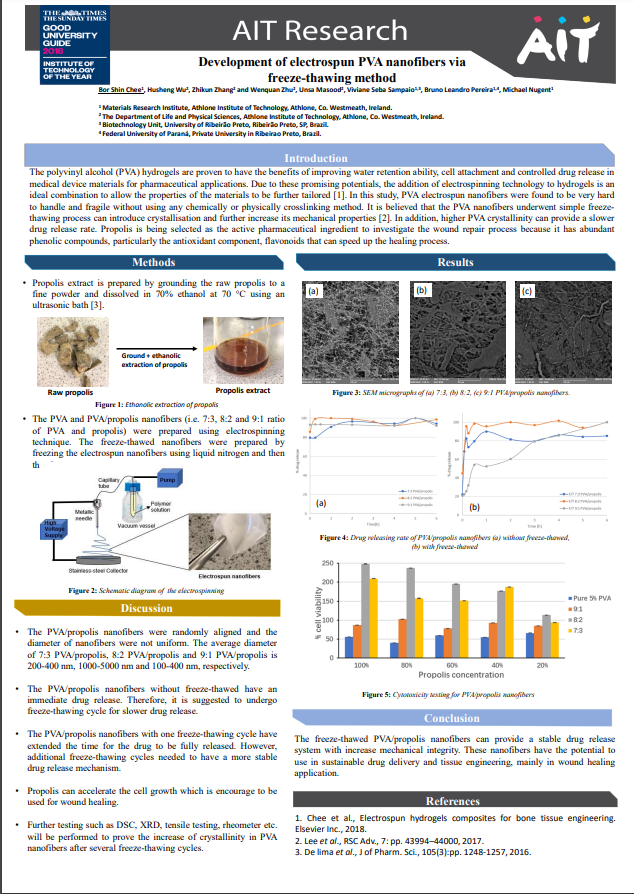Browsing Technological University of the Shannon: Midlands Midwest by Author "Pereira, Bruno Leandro"
Now showing items 1-10 of 10
-
Development of electrospun PVA nanofibers via freeze-thawing method
Chee, Bor Shin; Wu, Husheng; Zhu, Wenquan; Masood, Unsa; Sampaio, Viviane Seba; Pereira, Bruno Leandro; Nugent, Michael J.D. (Athlone Institute of Technology, 2019)The polyvinyl alcohol (PVA) hydrogels are proven to have the benefits of improving water retention ability, cell attachment and controlled drug release in medical device materials for pharmaceutical applications. Due to ... -
Effect of cullulose size-concentration on the structure of polyvinyl alcohol hydrogels.
de Lima, Gabriel Goetten; Ferreira, Bruno; Matos, Mailson; Pereira, Bruno Leandro; Nugent, Michael J.D.; Hansel, Fabríco Augusto; Magalhães, Washington Luiz Esteves (Elsevier, 2020-06-11)Microfibrillated cellulose as a reinforcement agent has been investigated extensively due to their unique characteristics, which can reorder the structure of polymers and hydrogels leading to improved mechanical properties ... -
Effect of thermal annealing on a bilayer polyvinyl alcohol/polyacrylic acid electrospun hydrogel nanofibres loaded with doxorubicin and clarithromycin for a synergism effect against osteosarcoma cells
Chee, Bor Shin; de Lima, Gabriel Goetten; de Lima, T.A.M.; Seba, Viviane; Lemarquis, C.; Pereira, Bruno Leandro; Bandeira, Marina; Cao, Zhi; Nugent, Michael J.D. (Elsevier, 2021-08-02)Polyvinyl alcohol/polyacrylic acid (PVA/PAA) bilayer hydrogel nanofibres were successfully fabricated by electrospinning and physically crosslinked via heat treatment. The effects of the thermal annealing process on the ... -
Enhancement of mechanical properties and wettability of TiO2NT arrays formed in simulated body fluid‐based electrolyte.
Simon, Anna Paulla; Santos, Vidiany Aparecida Queiroz; Rodrigues, Andressa; Santos, Janaina Soares; Strixino, Francisco Trivinho; Pereira, Bruno Leandro; Lepienski, Carlos Mauricio; Sikora, Mariana de Souza (Wiley, 2019-09-13)Modified titanium nanotubes (TiO2NTs) coatings are grown in simulated body fluid (SBF) from Ticp and Ti6Al4V. The addition of 1% v/v of SBF to the electrolyte neither modifies film morphology nor the structural oxide ... -
Oxide layer containing apatite formed on Ti-25Nb-25Ta alloy treated by two-step plasma electrolytic oxidation.
Pereira, Bruno Leandro; Beilner, Gregory; Lepienski, Carlos Mauricio; Szameitat, Erico Saito; Kuromoto, Neide Kazue; dos Santos, Leonardo Luis; Chee, Bor Shin; Alves Claro, Anna Paula Rosifini; Mazzaro, Irineu; Nugent, Michael J.D. (Elsevier, 2020-01-25)Hydroxyapatite (HA) is a bioactive calcium phosphate capable of enhancing the implant/bone connection improving osteoconductivity and osseointegration process. However, the HA presents mechanical properties limiting its ... -
Scratch-resistant and well-adhered nanotube arrays produced via anodizing process on β-titanium alloy
Pereira, Bruno Leandro; Beilner, Gregory; Lepienski, Carlos Mauricio; de Souza, Gelson Biscaia; Kuromoto, Neide Kazue; Szameitat, Erico Saito; Peng, Ambrose Ngu See; Lee, Jia Yee; Claro, Ana Paula Rosifini Alves; Nugent, Michael J.D. (Elsevier, 2021-03)Well-adhered nanotube arrays were produced through the anodizing technique on a Ti-25Nb-25Ta alloy and tribo-mechanically evaluated by nanoindentation and nanoscratch tests. Disregarding substrate effects, the hardness of ... -
Tailoring surface properties from nanotubes and anodic layers of titanium for biomedical applications.
de Lima, G.G.; da Luz, Aline Rossetto; Pereira, Bruno Leandro; Szez, Eduardo Mioduski; de Souza, Gelson Biscaia; Lepienski, Carlos Mauricio; Kuromoto, Neide Kazue; Nugent, Michael J.D. (Woodhead Publishing, 2019)The following chapter gives an overview of the anodic layers and nanotubes produced with plasma electrolytic oxidation. An introduction into the mechanisms involved in producing these nanofilms, such as the required ... -
Ti-25Nb-25Ta alloy treated by plasma electrolytic oxidation in phosphoric acid for implant applications
Beilner, Gregory; Pereira, Bruno Leandro; Lepienski, Carlos Mauricio; de Souza, Gelson Biscaia; da Luz, Aline Rosseto; Szameitat, Erico Saito; Kuromoto, Neide Kazue; Claro, Ana Paula Rosifini Alves; Sampaio, Viviane Seba; Chee, Bor Shin; Nugent, Michael J.D. (Rede Latino-Americana de Materiais, 2021)Among titanium alloys with non-toxic elements, the Ti-25Nb-25Ta alloy has good elastic behavior for applications in osseous implants, biocompatibility, and excellent corrosion resistance. The present study aimed to better ... -
Titanium-Niobium (Ti-xNb) alloys with high Nb amounts for applications in biomaterials
Pereira, Bruno Leandro; Lepienski, Carlo Maurício; Seba, Viviane; Hobold, Guibert; Soares, Paulo; Chee, Bor Shin; Kuroda, Pedro Akira Bazaglia; Szameitat, Erico Saito; dos Santos, Leonardo Luís; Grandini, Carlos Roberto; Nugent, Michael (Scielo, 2020-11-10)The present study produced binary titanium-niobium alloys Ti-xNb with high niobium percentage (x = 50, 80 e 90 wt.%) aiming to apply it as a base material in osseous implant devices. The produced TiNb alloys presented a ... -
Titanium-niobium alloys covered by electrospinning technique to applications in bone implants
Pereira, Bruno Leandro; Chee, Bor Shin; Nugent, Michael J.D.; cao, Zhi (Athlone Institute of Technology, 2019)Recently, to avoid toxic metals in the human environment, there are many efforts to produce alloys containing titanium Ti and niobium Nb. Nb is a powerful stabilizer of beta-titanium phase[1]. Depending on the composition ...


